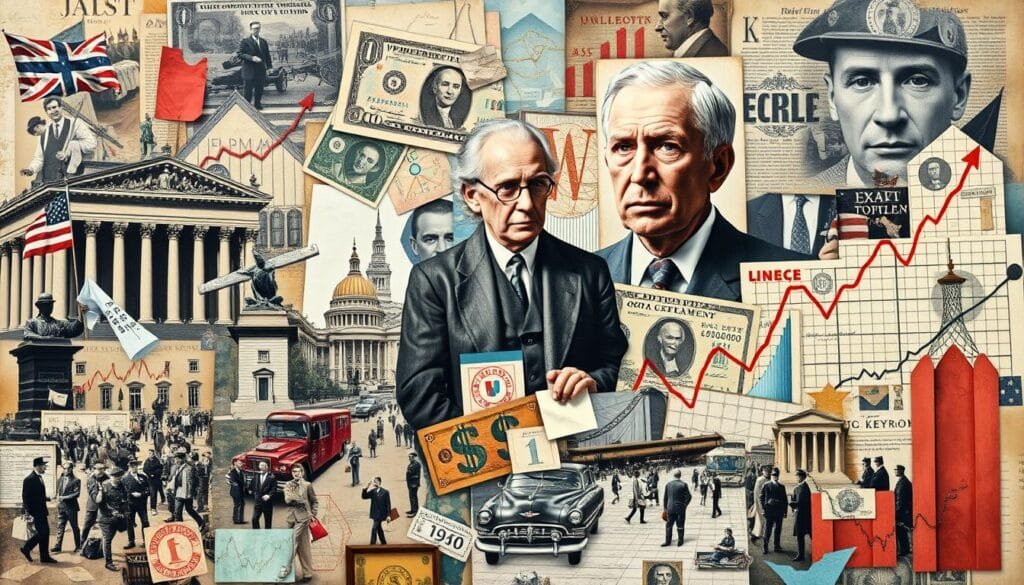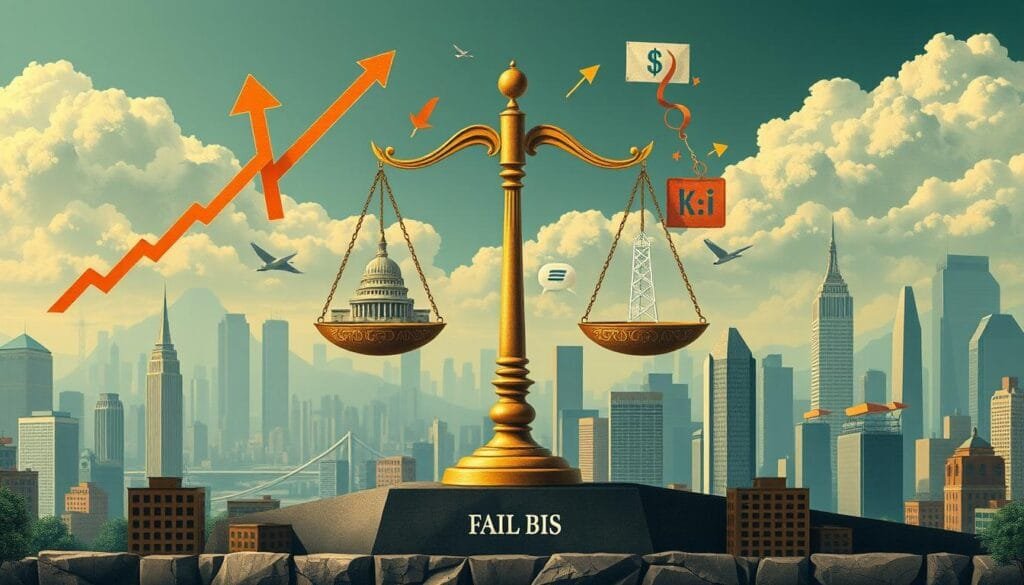Ever wonder why some think the government should step in during a recession? Others say it should back off. This big question is key to getting Keynesian Economics in AP Government.
John Maynard Keynes introduced his ideas when things were tough during the Great Depression. Traditional theories didn’t work when jobs were scarce; about 25% were without work, and the economy shrank by 30%. Keynes said spending more and taxing less could boost demand. This idea, tying into fiscal policy, helps stabilize the economy. Today, these thoughts guide us during hard times, like the 2008 crisis and COVID-19.
Learning about Keynesian Economics means understanding how total demand, government action, and economic health interact. It’s a big deal for AP Government students. This study not only informs on policy but also questions the usual view of government’s role in the economy.
Key Takeaways
- Keynesian Economics became big during the Great Depression, showing how crucial government action is when old methods don’t work.
- It highlights how crucial total demand is for the economy’s health.
- The approach encourages more government spending and lower taxes in slow times to boost demand.
- The multiplier effect explains how initial government money can greatly increase economic activity.
- Keynesian ideas were used in recent crises, like the 2008 financial crash and the COVID-19 outbreak, proving they’re still important.
Introduction to Keynesian Economics
Basics of Keynesian Economics were developed by John Maynard Keynes in the 1930s. This theory shapes how we view economics today. It highlights the government’s role in economics to keep the economy stable. Keynes believed consumer demand drives economic growth. He said dealing with low demand during hard times can cut unemployment and increase production.
Keynesian policy means the government should spend more and adjust taxes to boost demand. For example, after the 2008 financial crisis, countries used stimulus plans based on Keynes’s ideas. Keynes argued for spending more than income during economic lows. This was different from old ideas that stressed keeping budgets balanced.
Keynesians also suggest using counter-cyclical policies. They recommend more government spending during downturns and less during booms. This aims for economic balance and full employment. For instance, during the Great Depression, the money supply dropped by one-third. This showed the need for government action to fight low demand.
In his key book, ‘The General Theory of Employment, Interest, and Money’ from 1936, Keynes questioned old economic beliefs. He underlined the need for government intervention to lift demand. A core idea of Keynes is the multiplier effect. This theory says government spending can have a big, positive effect on growth.
In short, Keynesian Economics focuses on government action to ensure economic stability. It points out how important demand is in driving the economy. This view helps us manage the ups and downs of the economy.
Historical Context and Development
We start our journey into Keynesian economics during the Great Depression. This time was tough, with old economic theories not solving massive unemployment and failing markets.

The Great Depression and Keynes’ Response
The Great Depression’s economic chaos needed new solutions, as U.S. unemployment soared to 25%. John Maynard Keynes stepped in with new ideas. He said the government needed to act to fix economic ups and downs and avoid big crashes.
Keynes pushed for more government spending in bad times, like the recent COVID-19 relief efforts, which totalled over $5 trillion worldwide. He argued that doing nothing, or laissez-faire, wasn’t enough. The government had to step in to boost demand and cut unemployment.
Keynes vs. Classical Economics
The argument of Keynesian vs. Classical Economics focuses on how much the government should do. Before Keynes, Classical Economics wanted little government meddling, trusting the market to fix itself. But Keynes didn’t agree. He believed without help, economies would struggle with low performance and high joblessness for too long.
Keynes said spending could lead to growth and stability, unlike classical belief in supply-side only solutions. After World War II, his ideas ruled until the 1970s’ challenges. Yet, the 2008 crisis showed Keynesian ideas still matter today.
Knowing about these economic theories shows us how crucial government actions are in solving financial crises.
Core Principles of Keynesian Economics
Keynesian Economics suggests the government must step in during tough times. It aims to fix unemployment and economic slowdowns through managing demand. These efforts are based on three main ideas.

Aggregate Demand and Its Importance
Aggregate demand is key in this theory. John Maynard Keynes said that total economy spending controls its health. When the Great Depression hit, America’s economy shrank by 30%. This shows why increasing demand is vital.
By upping spending in both public and private sectors, the government can kickstart the economy.
Government Intervention and Economic Stability
The government’s role in keeping the economy stable is another key point. Keynes pushed for active fiscal policies. These ideas helped during the Great Depression, the 2008 crisis, and the COVID-19 pandemic.
For example, in 2008, Keynesian actions like a stimulus package of over $800 billion were used to fight a 10% job loss rate. Spending and tax breaks during the COVID-19 pandemic aimed to reduce unemployment. They helped grow the GDP by about 5% by 2021’s end.
The Multiplier Effect
The multiplier effect is vital to understand. It shows how a small increase in government spending can greatly boost the economy. For instance, $1 more in spending can create $1.50 to $2.00 in economic activity.
This was clear with the COVID-19 spending. The IMF says such spending can increase GDP by 1.5 times the original amount over years. This helps keep demand up, driving more investment and jobs.
Here’s a table summarizing the Keynesian approaches and their impact:
| Key Concept | Historical Example | Impact |
|---|---|---|
| Aggregate Demand Significance | Great Depression | GDP contraction by ~30% highlighted the need for demand management |
| Government’s Role in Economic Stability | 2008 Financial Crisis | Stimulus packages exceeding $800 billion mitigated a 10% unemployment rate |
| Keynesian Multiplier Concept | COVID-19 Pandemic | Fiscal spending led to a GDP increase of ~5% by end of 2021 |
what is kensian economics ap gov
Keynesian economics is a key part of American government policy. It was created by John Maynard Keynes in the 1930s. This was during the Great Depression. At that time, other economic theories couldn’t fix the high unemployment rate or the huge drop in GDP. So, Keynes suggested the government should step in during tough economic times.

In AP Gov, it’s important to understand Keynesian fiscal policy. It says the government can help the economy by spending more money and changing taxes. When there’s a recession, Keynesian economists recommend increasing government spending by 2-3% of GDP. This helps to kickstart the economy. They talk about the multiplier effect, too. It means that every dollar the government spends can increase the economy by $1.50 to $2.00.
Let’s look at some ways Keynesian ideas have been used and what happened:
| Keynesian Principle | Application | Outcome |
|---|---|---|
| Government Spending | TARP during 2008 financial crisis | $830 billion stimulus |
| Interventions during GDP drop | Great Depression | 30% GDP fall mitigated |
| Fiscal Stimulus | COVID-19 response | 10-20% of GDP in stimulus |
| Regulation and Oversight | SEC creation | Monitored stock trading to prevent crashes |
Keynesian fiscal policy also helps with unemployment and inflation. Data shows that stimulus measures can cut unemployment rates by 2-4 points in a year. After the 2008 recession, for example, these measures helped lower unemployment below 5% sometimes.
There’s a big discussion about Keynesian economics vs. supply-side economics. Keynesianism supports government spending to lower unemployment. Meanwhile, supply-side economics wants tax cuts for the wealthy to boost the economy.
In summary, knowing about Keynesian economics in AP Gov shows how these ideas help the government make smart choices. These choices support economic growth, stability, and can help in times of downturn.
Keynesian Economics and Fiscal Policy
Keynesian Economics focuses on using fiscal policy to manage the economy. It uses government spending and tax policies to fight recessions and keep the economy steady.
Government Spending
According to Keynesian Economics, government spending is key. In tough times, it boosts demand by investing in infrastructure, helping the unemployed, and improving public services. This spending triggers more economic activity.
For example, to combat the 2008 financial meltdown, governments spent over $1 trillion worldwide, following Keynes’ ideas. Similarly, in response to COVID-19, the U.S. spent about $5 trillion in stimulus packages.
Taxation and Economic Stimulus
Tax policies also matter a lot in fiscal policy in Keynesian Economics. Cutting taxes when the economy is down helps people spend more. This boosts demand further. The multiplier effect shows that $1 in government spending can lead to an increase in economic activity of 1.5 to 2.5 times that amount.
The 2009 U.S. deficit, which hit about $1.4 trillion, shows how important spending is in bad times. By changing tax rates, the government can drive consumption and help the economy grow.
Indeed, Keynesian fiscal strategies, like spending more and cutting taxes, can really help grow the GDP. Often, after a big government spending during a recession, GDP growth goes up by 2-3% in the following years. This underscores the critical role of fiscal actions in promoting economic stability and growth.
| Economic Event | Keynesian Approach | Outcome |
|---|---|---|
| Great Depression | Increase in government spending | Economic recovery, reduced unemployment |
| 2008 Financial Crisis | Global stimulus packages | Economic revitalization |
| COVID-19 Pandemic | U.S. stimulus packages | Economic stabilization |
Practical Applications in Government Policies
The Keynesian theory application has changed government actions, especially during tough times. It teaches how to make policies that help the economy recover and grow. We can see how well it works through many key examples in history.
President Franklin D. Roosevelt used Keynesian ideas in the Great Depression. His New Deal made about 8 million jobs from 1933 to 1941. These actions showed that spending money can make the economy better and lower joblessness, following Keynesian theory.
After the 2008 financial mess, countries used Keynesian ideas to spend about $1 trillion. This spending aimed to fix economies. It played a big part in helping countries bounce back, showing how useful Keynesian ideas are.
During COVID-19, the US spent around $5 trillion in Keynesian style to help. This aimed to fix the big economic problems from the pandemic. It showed again that Keynes’ ideas matter a lot during tough times.
A 2020 report showed 60% of economists think spending helps in downturns. This shows many experts agree with using Keynesian ideas to fix economic issues.
To really see how Keynesian actions work, look at these examples:
| Period/Event | Unemployment Rate | Government Intervention |
|---|---|---|
| Great Depression (1933) | Approx. 25% | New Deal Programs |
| Post-Great Recession (2010) | Fell from 10% to below 5% | Stimulus Packages |
| COVID-19 Pandemic (2020) | Varied across regions | Federal Emergency Relief ($5 trillion) |
These examples show how well Keynesian economics works. By spending, the government can boost demand, lower unemployment, and grow the economy. From the past to today, these strategies prove they work well.
Criticisms and Limitations of Keynesian Economics
Keynesian Economics has been key in modern economic policy-making. However, it isn’t without its faults. Its heavy reliance on government action is often criticized. Many worry it could lead to financial problems down the road.
Concerns Over Government Debt
One big criticism is how it affects government debt. Critics say regular fiscal stimulus could inflate national budgets. This could push countries towards debt they can’t manage. In the 1970s, some countries saw inflation over 10%. This was partly because of too much government spending and bad fiscal policy.
Those who advocate for fiscal responsibility push for balanced budgets. They warn against always increasing public spending. They fear too much debt could lead to long-term fiscal troubles. This could threaten a nation’s economic stability.
Market Distortions
Critiques also touch on possible market distortions. Things like subsidies or tax breaks can mess up how resources are used. For example, favoring some industries might hurt market efficiency. This can cause economic imbalances.
Stimulus measures often bring short-lived economic boosts, not lasting growth. Public spending might help in the moment but ignores deeper issues. Those who favor market efficiency argue for less interference. They believe markets should correct themselves, following classic economic ideas.
Below is a table showing the impacts of Keynesian policies and their criticisms:
| Aspect | Positive Impact | Criticism |
|---|---|---|
| Government Spending | Boosted GDP growth by about 4% annually in the 1950s and 1960s | May lead to government debt |
| Unemployment Rates | Dropped to below 3% by the mid-1960s | Could cause inflation and upset the market |
| Fiscal Stimulus | Helped reduce how long recessions lasted to 12-24 months | Could waste resources |
| Economic Stability | Made the economy more stable after World War II | Risk of long-term fiscal problems |
Conclusion
Keynesian Economics has deeply changed modern economic policies. It shows us the role of government in markets. This theory was born during the tough times of the Great Depression. It offered a plan for governments to help avoid economic downturns. Governments can do this through smart spending and tax cuts, said John Maynard Keynes.
The Keynesian fiscal multiplier is a key idea here. It suggests that government spending can create more growth than the amount spent. This idea supports the use of fiscal stimulus when confidence is low. Historical events like Roosevelt’s New Deal and the 2007-2008 financial crisis show how Keynesian ideas work to lower unemployment and boost economic stability.
Still, not everyone agrees with Keynesian economics. Some worry it might not always work as expected. They fear it could lead to long-term debt problems and disrupt the market. Yet, the main principles of Keynesian economics stand strong in today’s economic discussions. They focus on government action, boosting demand, and finding a balance between controlling inflation and keeping people employed. As we face both expected and unexpected economic challenges, Keynes’ ideas help guide our path to continued growth and stability.
FAQ
What is Keynesian Economics?
A: Keynesian Economics is an economic idea by John Maynard Keynes. It suggests more government spending and lower taxes to boost demand. This is especially useful during tough economic times. It also points out how vital demand is for the economy and supports government action to manage economic ups and downs.
Why is Keynesian Economics significant in AP Government studies?
A: In AP Government, Keynesian Economics teaches how fiscal policy manages the economy. It’s crucial for understanding government spending and tax decisions. These affect economic stability and growth, especially during downturns.
How did Keynesian Economics emerge as a notable theory?
A: It emerged during the Great Depression when old theories couldn’t fix the crisis. John Maynard Keynes suggested government intervention to boost demand and reduce unemployment. This idea led to Keynesian Economics.
What are the core principles of Keynesian Economics?
A: The main ideas include demand’s role in the economy, government’s job to stabilize it, and the multiplier effect. An initial spending increase often leads to greater economic activity.
How does government intervention contribute to economic stability according to Keynesian theory?
A: Government intervention helps by adjusting demand through fiscal policies. Methods like spending more and altering taxes can fight off recession impacts. They lessen unemployment and drive growth.
What role does government spending play in Keynesian Economics?
A: Government spending boosts the economy by funding infrastructure, unemployment benefits, and public services. It lifts demand and economic activities. This support is crucial during economic slumps and for recovery.
How does taxation affect economic stimulus in Keynesian Economics?
A: Tax policies aim to increase consumer spending by lowering taxes. This boosts economic demand and growth by giving people more money to spend.
What are some practical applications of Keynesian Economics in government policies?
A: Keynesian ideas are seen in policies like the New Deal and recent fiscal stimuli during economic crises. Examples include the 2008 financial crisis responses and measures during COVID-19. These reflect Keynesian strategies for overcoming downturns.
What criticisms and limitations are associated with Keynesian Economics?
A: Critics say too much government action can lead to huge debts and market problems. They worry about long-term financial health and whether Keynesian methods are sustainable.
